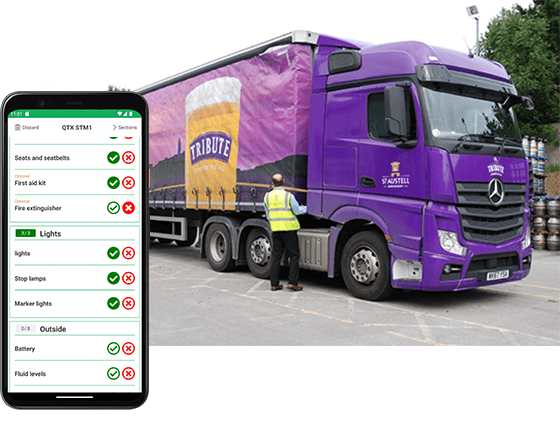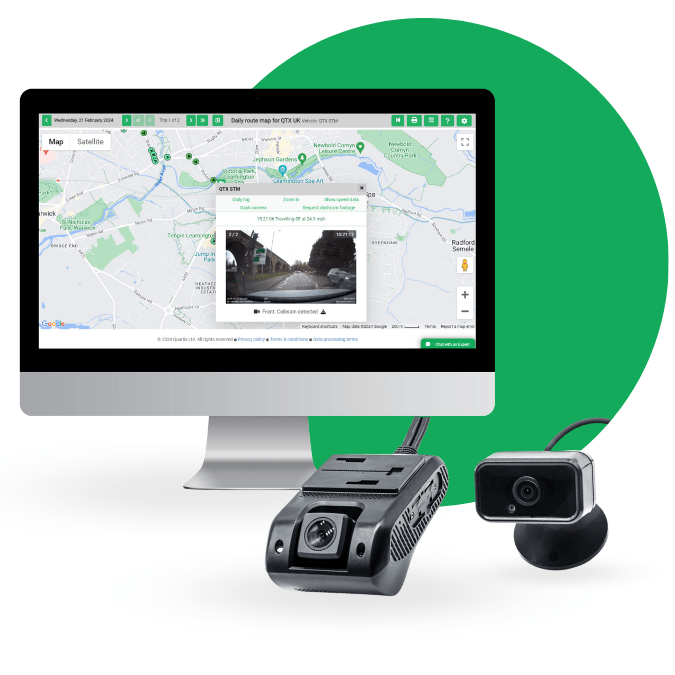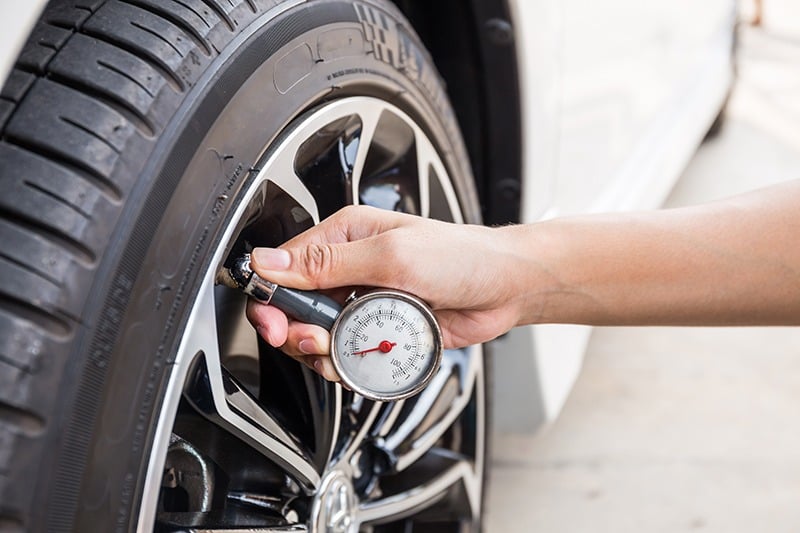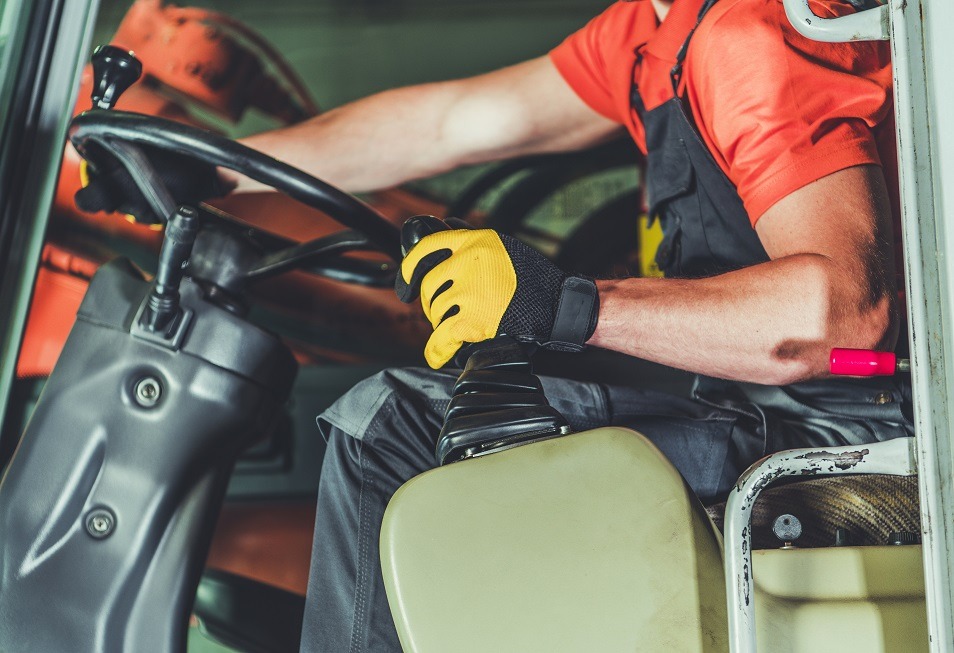See for yourself how Quartix works with our fully interactive real-time demo.
Ensuring the safety of goods transported by vehicles is crucial for preventing accidents and maintaining road safety. If your business operates a fleet of company vehicles, whether Light Goods Vehicles (LGVs) or Heavy Goods Vehicles (HGVs), it’s essential to stay updated on the latest regulations. In this article, we will explain the recent changes to the rules for securing loads on your goods vehicles based on the updated guidance from the Driver and Vehicle Standards Agency (DVSA) as of December 9, 2024.
The proper securing of loads is not just a regulatory requirement but a fundamental aspect of transportation safety that can save lives, protect resources, and shield your business reputation.
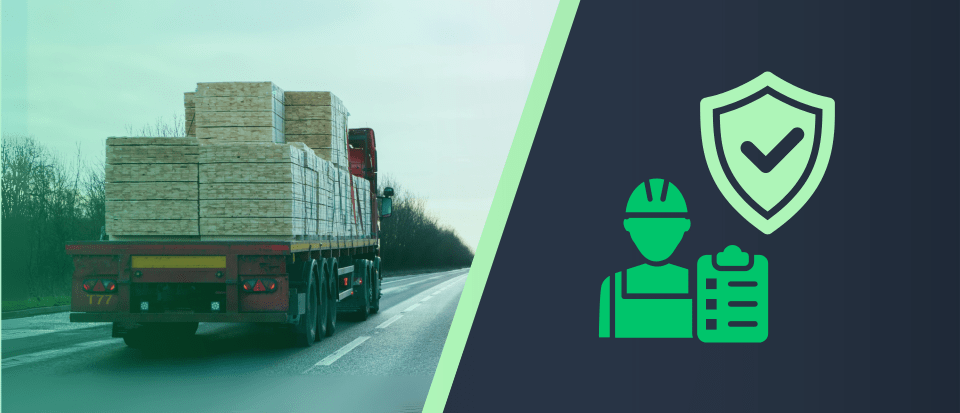
Why Securing Loads is Important for Your Business
Securing loads on vehicles not only ensures the safety of the driver, the vehicle and its goods, it also protects other road users. Unsecured loads lead to accidents, causing damage and injury. In some cases, unsecured loads can result in fines or legal action against the driver or company.
Beyond legal repercussions, accidents caused by unsecured loads can have a significant impact on repair costs, compensation claims, and increased insurance premiums. Companies known for neglecting safety may find it challenging to maintain customer trust or secure future contracts.
Properly securing goods loads should from a critical part of your risk management strategy. Here’s everything you need to know.
What Are the Dangers of Unsecured Loads?
Loads can shift during transportation if not secured properly. This can lead to:
- Vehicle instability: Increasing the risk of rollovers or loss of control. An unstable vehicle is more difficult to manage, especially during emergency manoeuvres or adverse weather conditions, heightening the potential for accidents.
- Hazards to other vehicles: Items falling onto the road can cause dangerous obstructions, distractions and collisions. This can result in severe traffic disruptions and endanger the lives of other road users.
- Damage to the goods: Resulting in financial losses and customer dissatisfaction. Damaged goods may also lead to breaches of contract and the subsequent loss of future business opportunities.
- Legal penalties: Non-compliance with safety regulations can result in fines, penalties and even criminal charges depending on the severity of the incident. Legal consequences can extend to your business, impacting operational licenses and increasing scrutiny from regulatory bodies.
A tragic real-world example underscores the importance of securing vehicle loads. In December 2022, a boy lost his life when an unsecured scaffolding board fell from the back of a van and through the windscreen of the car he was traveling in with his father in East Sussex. The van driver was sentenced for causing death by dangerous driving and had his license suspended.
What Are the Penalties for Driving an Unsecured Load?
Operating a vehicle with an unsecured load carries significant legal and financial repercussions:
- Legal Penalties: Drivers can face fines up to £5,000, receive three penalty points on their driving license, and potentially face disqualification from driving. In severe cases, such as causing death by dangerous driving, imprisonment for up to 10 years is possible.
- Business Liability: Companies can be held responsible if they cause or permit the operation of vehicles with unsecured loads, leading to legal action against the business.
Securing Goods Vehicle Loads: What Are the Rules for Businesses?
Ensuring the safety of goods transported by vehicles is crucial for preventing accidents and maintaining road safety. If your business operates a fleet of company vehicles, whether Light Goods Vehicles (LGVs) or Heavy Goods Vehicles (HGVs), it’s essential to stay updated on the latest regulations. In this article, we will explain the recent changes to the rules for securing loads on your goods vehicles based on the updated guidance from the Driver and Vehicle Standards Agency (DVSA) as of December 9, 2024.
The proper securing of loads is not just a regulatory requirement but a fundamental aspect of transportation safety that can save lives, resources, and protect your business reputation.
Key Legislations
- Road Traffic Act 1988: This act states that drivers are responsible for ensuring their vehicle is not overloaded and that the load is secured. The Act outlines specific penalties for non-compliance, emphasising the importance of adhering to load limits and proper securing techniques.
- Workplace Transport Safety: The Health and Safety Executive (HSE) provides guidelines on safely loading and securing goods on vehicles. These guidelines protect employees and the public, and they offer practical advice on implementing safety measures in everyday operations.
- The DVSA Load Security Regulations: These regulations specify the standards for securing loads on vehicles, providing detailed criteria for different types of loads and securing methods. Compliance with these standards is mandatory and critical for safe transportation practices.
Changes Introduced by the DVSA in December 2024
The DVSA introduced several key updates to improve road safety and compliance for businesses operating goods vehicles. Here is a summary of the changes that you can read in full on their website:
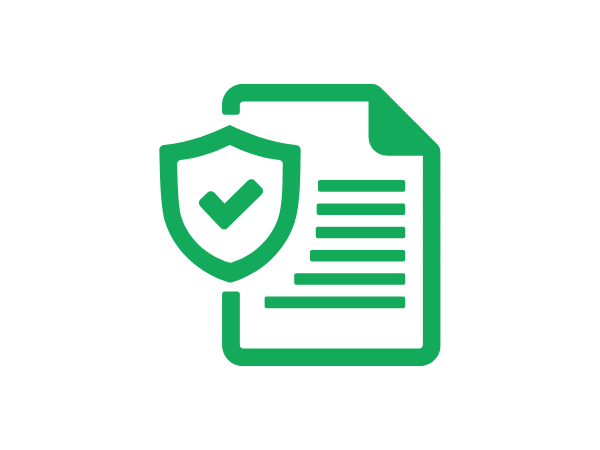
Increased Operator Responsibilities
Businesses must now conduct more thorough risk assessments and implement documented processes for securing loads to comply with stricter enforcement.

Driver Accountability
Drivers loading vehicles must use appropriate securing equipment and undergo mandatory training to ensure compliance with updated load security standards.

Consignor Obligations
Companies that arrange goods transportation have additional responsibilities to verify that all loads are adequately secured before transportation begins.
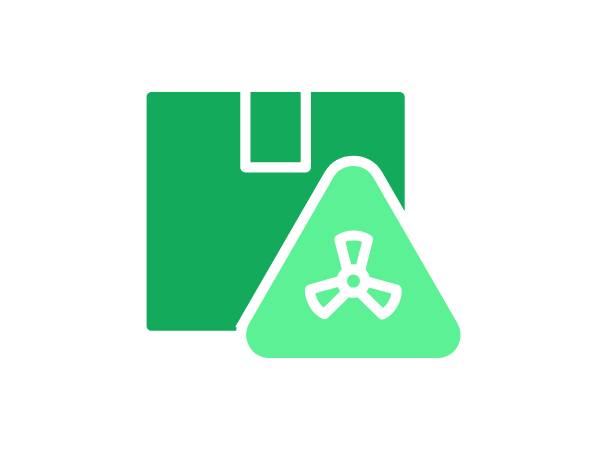
Dangerous Goods Legislation
The updated regulations now place greater emphasis on dangerous goods transportation, incorporating specific security measures to align with existing hazardous materials laws.
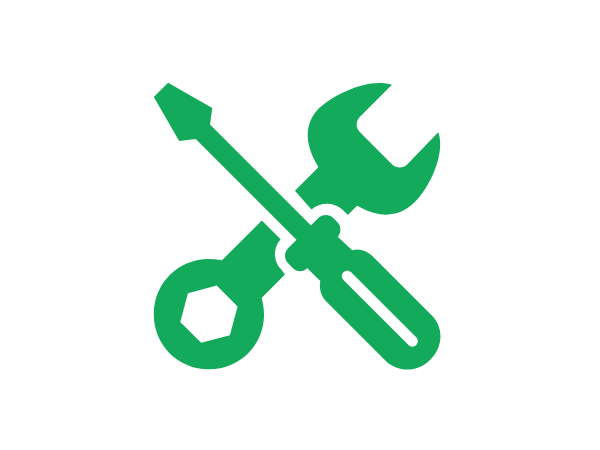
Load Securing Guidelines
New recommendations regarding friction, securing oversized or tall loads, and ensuring that load removal does not affect overall stability.
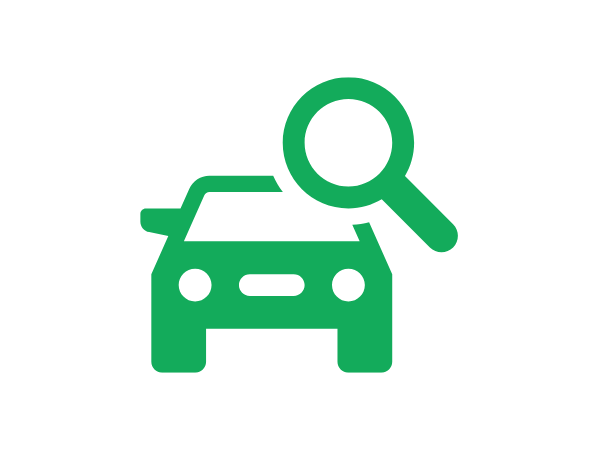
Evidenced Regular Load Checks
Drivers must now perform more frequent load inspections during transit, and keep detailed records as evidence of compliance.

Stronger Enforcement Penalties
Businesses found to be non-compliant with the updated load securing standards face heavier fines, potential license loss, and increased scrutiny from regulatory authorities.

Equipment Standards
Guidance now specifies the use of high-strength securing equipment, and discourages the combination of lashing straps (ratchet straps), and chains to avoid load instability.
How to Secure a Vehicle Load
Assess the Load
Before loading, assess the type and weight of the goods. This will determine the best method for securing the load. Consider the following:
- Weight Distribution: Ensure the load is evenly distributed across the vehicle to maintain balance. An unevenly distributed load can lead to vehicle instability, increasing the risk of accidents during transport.
- Load Type: Different types of loads require different securing methods. For example, liquids may need a different approach than solid goods. Understanding the characteristics of the load will help in selecting the appropriate securing equipment and techniques.
Additionally, consider the fragility and value of the goods being transported, as these factors may call for additional protective measures. Engaging with logistics experts can further enhance your ability to secure loads effectively.
Use the Right Restraints
Choose restraints suitable for the load:
- Straps and Chains: For large or heavy items, to prevent movement of bulky goods.
- Nets and Tarpaulins: To cover and secure loose or small items, offering protection from rain and wind, which can affect load stability.
- Load Bars and Gates: For added support, maintaining load integrity during long-distance transport or when navigating challenging or bumpy road conditions.
The updated DVSA guidance recommends against combining lashing straps and chains. Securing parts of a divisible load higher than the headboard also requires additional measures. This guide explains how to use ratchet straps to secure a load to your vehicle.
Choosing the right restraints is critical, and investing in high-quality equipment can prevent costly accidents. Regularly inspect your securing devices to ensure their effectiveness.
Regularly Check Load Security
During transit, regularly check that the load remains secure, especially on long journeys or rough terrain.
- Inspect the restraints at each stop. Regular inspections can catch issues early, preventing potential accidents before they occur.
- Adjust or tighten restraints as necessary. Environmental factors such as temperature changes can affect the tension of restraints, necessitating adjustments to maintain load security.
Implementing a routine vehicle check schedule can enhance the safety and security of your loads during transit. For tips on more general vehicle safety checks and how often you should perform these, see our guide to fleet safety inspections.
Understanding where your drivers are at any time can be crucial in an emergency. Live tracking systems keep an accurate log vehicle activity to help you stay on top of your business operations. Check out our guide to using fleet tracking technology to stay competitive as an SME and learn how to secure courier and back-haulage jobs more easily – turning empty miles into profit for your business.
Training and Awareness for Your Team
Ensure all drivers and loading staff are trained in load securing techniques and understand the legal requirements, including:
- Understanding the types of equipment available and their correct use. Proper training ensures that staff can efficiently use securing equipment, reducing the risk of human error.
- Knowing how to assess loads and choose appropriate securing methods. Continuous education and training updates keep drivers up to date with evolving safety standards.
Investing in training programs not only enhances safety but also boosts employee confidence and competence in handling diverse loads.
3 Common Mistakes Businesses Should Avoid
1. Overloading Vehicles
Overloading a vehicle can lead to instability and increase the risk of accidents. Always adhere to the vehicle’s maximum load capacity and distribute weight evenly. It is crucial to understand the manufacturer’s specifications for load limits and to use weighing equipment to verify compliance.
Ignoring load limits not only endangers safety but also accelerates wear and tear on the vehicle, leading to increased maintenance costs and potential mechanical failures.
2. Inadequate Load Restraints
Using insufficient or inappropriate restraints can cause loads to shift during transit. Always choose restraints that are suitable for the load type and weight. Invest in high-quality securing equipment and ensure it is used correctly to reduce the risk of load movement.
Regular training on the proper use of restraints and using quality control measures help prevent these errors.
3. Ignoring Load Movement
Failing to check loads during a journey can lead to dangerous shifts. Regularly inspect the load and make adjustments as needed. Various factors can influence load shifts, including road conditions and driving behaviour.
Implementing a proactive approach to load checking, along with using modern technology for monitoring, can help mitigate the risks associated with load movement.
Assess Your Load Security Today
Securing loads on goods vehicles is a crucial aspect of road safety and legal compliance. By understanding and adhering to the updated DVSA rules and best practices, your business can protect its drivers, goods, and reputation as well as other road users. Ensure your team is trained and equipped with the right tools to effectively secure loads.
By prioritising load security, you help create a safer road environment for everyone. Stay informed, stay compliant, and always double-check your loads before hitting the road.
For a comprehensive vehicle inspections app for your company drivers, see our Quartix Check solution.
